The Intel Core i3 530 Review - Great for Overclockers & Gamers
by Anand Lal Shimpi on January 22, 2010 12:00 AM EST- Posted in
- CPUs
The Performance & Power Summary
I’ve added the Core i3 530 to our Bench database, if you want a full comparison of results head over there. What I’m providing here is a subset of our tests to show the 530’s strengths and weaknesses.
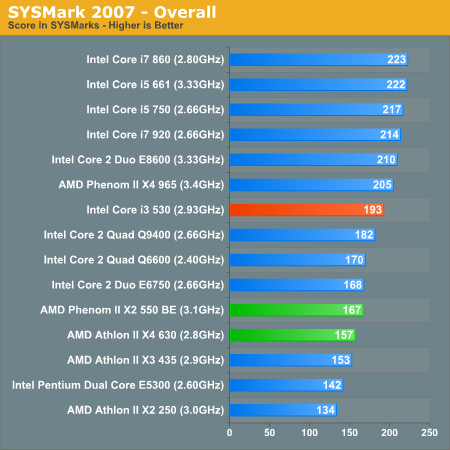
In every single non-gaming test, the Core i3 530 bests the Phenom II X2 550 BE. In our gaming benchmarks the 550 was faster in two out of our 8 benchmarks. In the rest, the i3 took the lead. The Core i3 530 also manages to outperform the Phenom II X2 550 BE while using significantly less power. In the battle of the dual-cores, the i3 wins. AMD needs to fight with clock speed at at 3.1GHz, the 550 can’t muster enough to beat the i3.
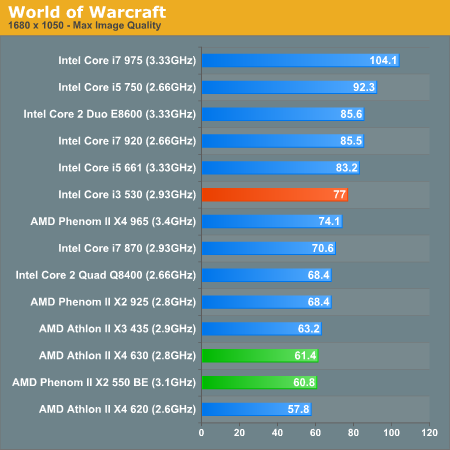
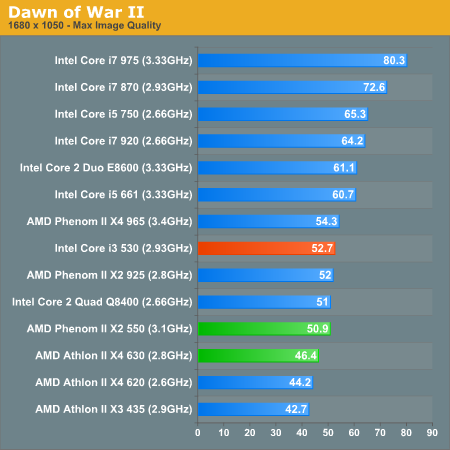
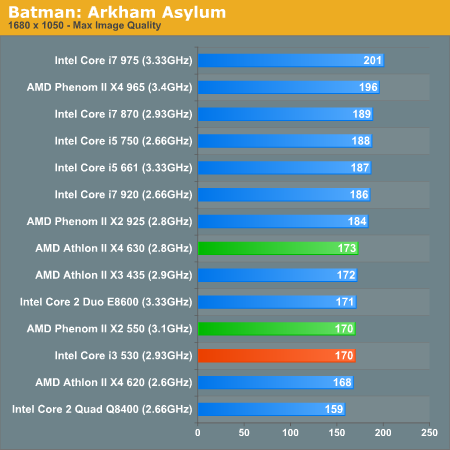
The Athlon II X4 630 comparison is a little more complicated. In single and lightly threaded applications, the i3 is a much better performer thanks to its higher clock speed. The i3's gaming performance is also significantly better across the board. What the Athlon II X4 loses in clock speed, it makes up for in core count. Things like video encoding and offline 3D rendering are almost always faster on the Athlon II X4 630.
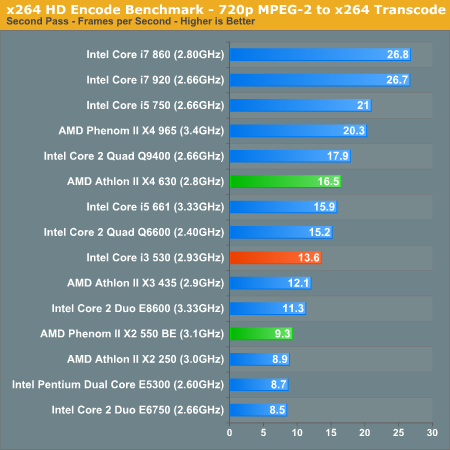
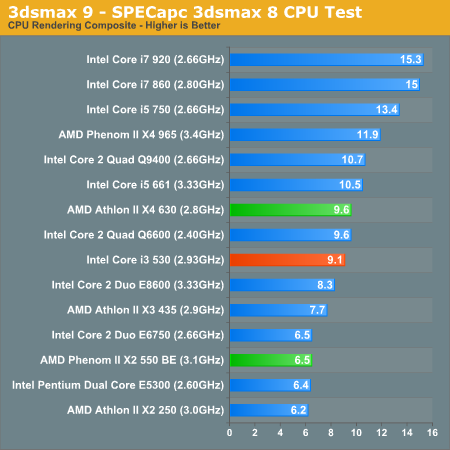
Applications that are bound more by the performance of one or two threads are almost always faster on the Core i3 530. As a general purpose desktop microprocessor or a chip for a gaming rig, I’d opt for the Core i3 530. If you’re doing a lot of heavily threaded content creation, then the Athlon II X4 is the chip for you. If you’re somewhere in between, the choice is up to you. Our Photoshop test has the two processors very close to one another, but with the i3 taking the slight lead.
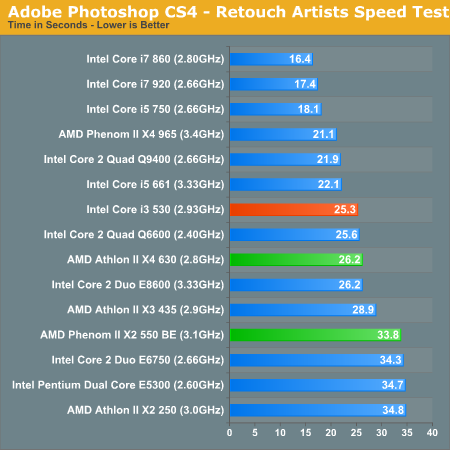
Power efficiency obviously goes to the Core i3 530 thanks to its 32nm transistors.

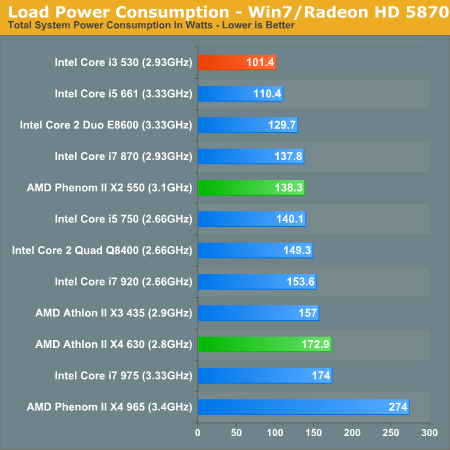










107 Comments
View All Comments
marc1000 - Friday, January 22, 2010 - link
its interesting how close in performance the e8600 is to the i3... of course you loose some power efficiency but if you already have a good discrete GPU and a e8600 (or another older penryn clocked to e8600 levels, as it is my case), then none of the new CPU's are ground-breaking deals... they are faster, of course, but they are also expensive. not funny. going from a P4 to a Penryn was really great, but from a Penryn to these new ones... its just "good".Grooveriding - Friday, January 22, 2010 - link
Any chance of seeing some comparisons of this chip at 4ghz vs an i7 920 at 4ghz. I'd love to get an idea of how it compares clock for clock in gaming against the 1366 platform.Be interesting to see if it's better just getting this if you're a gamer.
cmdrdredd - Friday, January 22, 2010 - link
2.66Ghz i7 920 vs 2.93Ghz i3 530 is already there. The 2.66Ghz i7 is on average 10fps faster. Overclocking both to 4Ghz would have the same results if not even furthering the gap. Why? Because a slower clock speed CPU is already faster. So equaling the clock speed doesn't mean equaling performance.strikeback03 - Friday, January 22, 2010 - link
Even better, if they could add overclocked results they already have to Bench.ltcommanderdata - Friday, January 22, 2010 - link
I'm wondering if overclocking the IGP's shader units overclocks the memory controller as well since they are on the same die? That would help explain the good performance scaling. As well, was power consumption significantly different with the IGP at 1200MHz? If not, then Intel should definitely have clocked their IGPs higher. Catching up to current gen IGPs from nVidia and ATI is noteworthy for an Intel IGP, but presumably nVidia and ATI have their next gen IGPs right around the corner and Intel's IGP doesn't push new performance boundaries.IntelUser2000 - Monday, January 25, 2010 - link
No, the IGP is on its own clock domain. You can overclock the iGPU seperately from everything, even the base clock. On the motherboards which allow overclocking of the iGPU on Clarkdale, you don't have multiplier options, but a straightforward frequency adjustment.Abhilash - Friday, January 22, 2010 - link
sysmark is absurdAbhilash - Friday, January 22, 2010 - link
http://www.anandtech.com/bench/default.aspx?p=112&...">http://www.anandtech.com/bench/default.aspx?p=112&...karlkesselman - Friday, January 22, 2010 - link
hi,On page 2, Load Power Consumption you have i870 using less power than i750. This can't be. It's either a misprint or the "load" test doesn't fully stress the i870 or maybe some hardware misconfiguration.
Then there is the WoW test.
i750 has 92 fps
i530 has 77 fps
and
i530 (OC @ 4 GHz) has also 92 fps
We know that WoW only uses 2 cores so i750 must be having turbo boost enabled running @ 3.2 GHz. That explains why it gets 92 fps. But then the i530 @ 4 GHz gets the same fps. This is either a mistake (was the test running the same hardware?) or i530 is less efficient then i750 (at least running WoW; maybe because of the memory controller and/or the 8 MB L3 cache or both?).
Also in this case (WoW test) it would be interesting if we could see the power consumption during the test (i750 compared to i530).
Anand Lal Shimpi - Friday, January 22, 2010 - link
Our 870 has always used slightly less power than our 750 sample. A while ago Intel did away with having a single voltage for each product shipped. In my experience, the higher end chips are usually the ones that can run at the lowest voltages.All of our Core i7/i5 numbers are run with Turbo enabled, but remember that Clarkdale's memory performance isn't as good as Lynnfield. We see this manifest itself in more than just WoW. If you have the money, you're better off with Lynnfield. But at $113 you're at nearly half the price of the cheapest Lynnfield.
Take care,
Anand